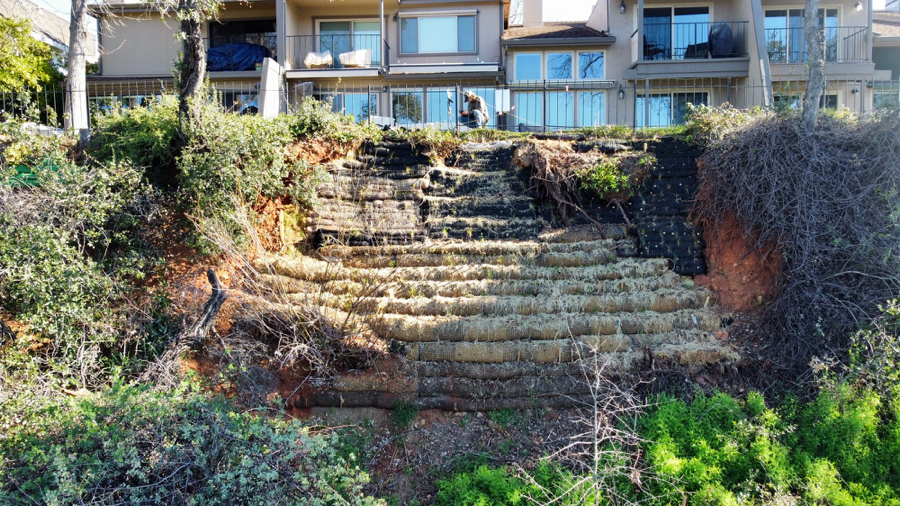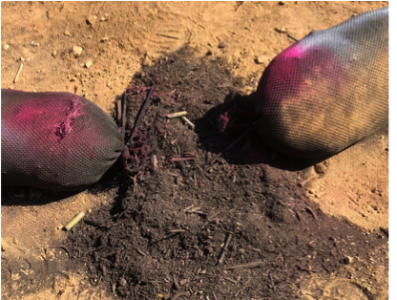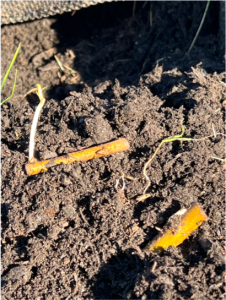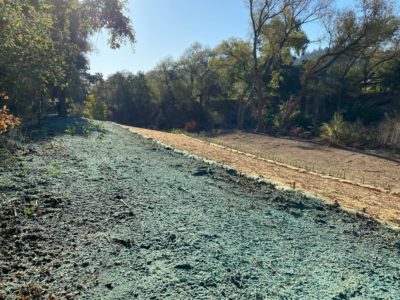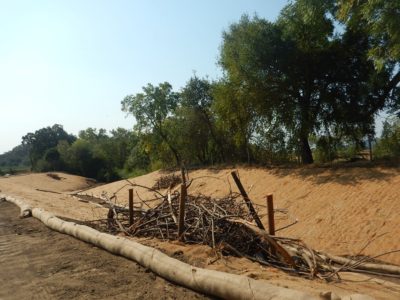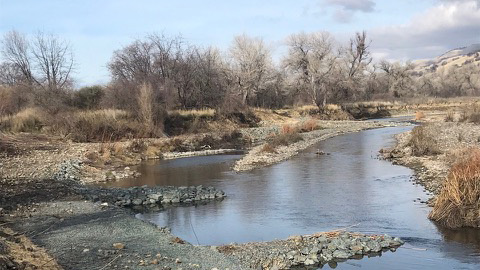Posted at 14:07h
in
Featured
Bluffs Project 2 – Fall 2021
Project Techniques:
- Vegetated Mechanically Stabilized Earth (VMSE) and Modified Filtrexx Soxx – Living Wall Techniques,
- Custom-filled Grow Soxx – Redding Greenwaste Compost, native grass seed blend, and mychorrizae added to soxx,
- Willow brushlayering – branches soaked for 10 days minimum,
- Native grass plugs, Nassella pulchra and Elymus glaucus planted into socks with dibble,
- Temporary drip irrigation installed
The VMSE and Grow Soxx Living Wall techniques were again chosen to arrest steep slope erosion at the Bluffs Condominiums in Redding CA.
Bluffs Project 1 was implemented and successfully completed in January, 2019. Encase you missed it check out the first Bluffs project summary here.
 |
 |
| Figure 1 |
Figure 2 |
| Figure1 and Figure 2 “Bluffs 1” soil slope stability project completed in January 2019 and after the photo was taken March 2022. See BLOG for more details |
| |
Problem Statement
A soil stability analyses was conducted and determined that basically the Bluffs (a very steep and 200-300 ft high geologic feature that formed millions of years ago and was then carved by the Sacramento River, along the outer bank, thousands of years ago) is a relatively stable feature. The exposed bluffs have metamorphosed into a very stable conglomerate that is not prone to slope failure, although it has been incised by drainages running across the top of the bluffs and allowed to run over.
The more localized problems facing the “BLUFFS Condominiums” and HOA (developed in 1970s) were determined to be caused, not by systemic instability of the steep slopes, but instead the slumps and soil failures were caused by both broken irrigation lines and “wind throw” of some oak trees growing on the edge of the 200-ft high bluffs. Note that the slope below the condominium development is well vegetated native shrubs and trees common to the Sacramento Riparian zone, Oak, cottonwood and important for this project, willow species. The most stable areas downslope, but still hundreds of feet above the river, is willow species. Once again, according to the authors experience and opinion, willow appears to be “pioneering species” that provides masses of fibrous roots to help “nature” heal itself for an initial period while then ‘surrendering’ the stabilized soil area to more climax species.
The second BLUFFS repair was initiated in phases. The 30’ high repair was ‘anchored’ at the bottom on a 3’-wide flat area, little more than a game trail.
As with the previous Bluffs project, access to the slumping area was limited to wheel barrow and hand carrying. All work had to be performed with hand tools.
 |
 |
| Figure 3 |
Figure 4 |
| Figure 3 and 4 The lower portion of the 30-ft high slump/gully repair used 10 (ten) lifts comprised of coir BioD logs and Blocks, reinforced with willow brushlayering – 4-5’long branches placed, dipping 10-20 degrees into the fill, at a rate of 2-3 branches per foot |
 |
 |
| Figure 5 |
Figure 6 |
| Figure 5 and Figure 6 Willow branches were kept moist while being harvested and delivered to the site. As per Harvesting and handling techniques documented in NCHRP Report 544 – Environmentally Sensitive Channel and Banks Techniques, 2005, J.McCullah, Transportation Research Board. Figure 5 shows coir BioD logs and Blocks used to stabilize and support the face of the Vegetated Mechanically Stabilized Earth (VMSE). |
VMSE is one of 54 techniques identified by McCullah, et.al. in the Federal Highways / Transportation Research Board commissioned research to identify “alternatives to rip rap” that could be integrated into environmentally-sensitive highway projects. NCHRP Report 544- Environmentally-Sensitive Channel and Bank Protection Methods , aka E-SenSS published by McCullah identify over 50 methods that not only protect channels and streambanks but also provide habitat enhancements. The reports provide selection guidance, construction specifications, Auto-cad (dwg) and Microstation (dgn) typical drawings of techniques like Rock Vanes, Bendway Weirs, Large woody debris, Brushlayering, Live Siltation, Longitudinal Stone Toe protection, and Engineered Rock Riffles.
These are methods that the author has designed, built, and demonstrated for over 15 years now, including sensitive projects like CalTrans Highway 128, Russian River Geyserville Bridge protection utilizing 5 redirective rock vanes, live siltation, flood terrace with Live Pole Plantings. McCullah also designed and demonstrated, as week-long workshops of sensitive Alberta Highways projects in the Canadian Rockies. Projects also include bank stabilization (the first time using Coir BioD Logs with willow brushlayering) on the Chena River in Fairbanks. This project built in 2006 is still stable today (a wall of willow, sustainably pruned, is still supported by the long-lasting coconut logs and soil-filled ‘bio-bags’.
John used the NCHRP techniques in a successfully-implemented, 8000ft-long urban stream repair and modification in Auckland New Zealand while he also designed a huge engineered (Newbury) rock riffle for grade control on the Pedu River in the mountainous northern region of Malaysia. The design criteria were taken from the NCHRP Report 544. Future blogs will describe these projects in depth.
 |
| Figure A |
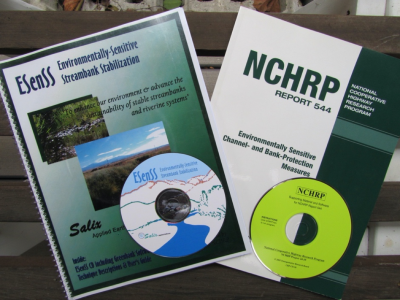 |
 |
|
|
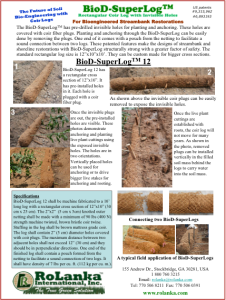 |
 |
|
|
 |
 |
| Large VMSE highway fill project on Hwy 330 in San Bernardino County |
|
| Figure A descriptive flyer showing the “invisible” 2-inch diameter holes manufactured into the BioD Logs and Blocks. The right hand photos show a VMSE wall built on the right descending bank of Cache Creek. To protect the Cache Creek Golf Course, redirective Bendway Weirs (BW), designed to move the high energy vectors of “impinging flows” (the thalweg) away from the bank were combined. The NCHRP report 544 document studies and flume tests that show redirective methods, such as Bendway Weirs and rock Vanes can move the high-energy erosive flows, defined by the location of the stream’s thalweg, over 20% of the streams bankfull width streamward and away from the bank! See the Bendway Weirs above which effectively moved the thalweg to a location “off the BW tips. The once area of high velocity impinging flows is now a low velocity flood terrace. Post project vegetative growth was so thick an after photo is very difficult. |
 |
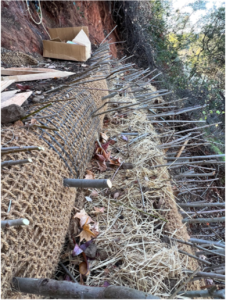 |
| Figure 7 |
Figure 8 |
| Figures 7 and 8, The BioD blocks were chosen because of their durability and longevity (ability to secure soil until willows and grasses become established) and because they are manufactured with holes through the blocks/logs which allow willow branches and or securing devises, like Gripple Anchors, through the logs. |
Custom-filled Grow Soxx was used for the upper section of the project. A Finn BB302 Bark Blower was rented from Global Machinery for a day. We filled over 600 lf of Grow Soxx using Filtrexx fill sock material. Because of the tight access, all the materials had to be brought in by hand. Filling our own socks allowed much flexibility.
We filled soxx with compost that was well cured and added native grass seed and mycorrhizae fungi. Look carefully and you’ll see that a few socks had willow cuttings added as a trial – they sprouted within the soxx is a couple of weeks but the sprouts never were observed to penetrate the sock netting.
We also obtained from Filtrexx some new soxx made of biodegradable material. It will be interesting to see how durable the material is, but so far the biodegradable soxx have maintained structural integrity for almost 5 months.
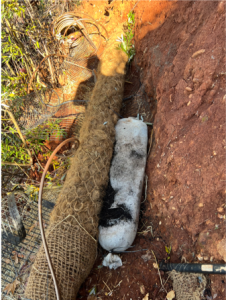 |
 |
|
|
| Figure The “component nature” of the 4ft long compost soxx allowed a lot of flexibility in construction- we could “fill” behind the Coir logs with compost filled soxx and fit the soxx segments around and between existing stabilizing shrubs. Below the vegetated grow soxx were fit between and under the branches and roots of an existing California wild grape (Vitis californica) |
| |
Final Results








